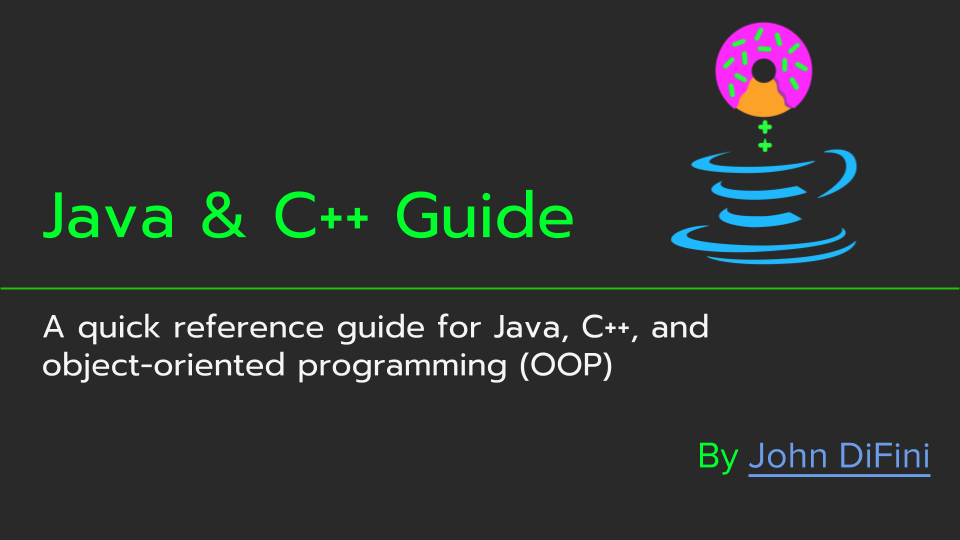Java & C++ Guide
Overview
Classes
Inheritance
Collections & Containers
Multithreading
Miscellaneous
Classes
Static Members
Static members have class scope as opposed to object scope
Classes Defined within Other Constructs
Pass-by-value & Pass-by-reference
Many argue that Java is ONLY pass-by-value, but I'd argue that it's much more nuanced than that.
Best explained by the following examples:
Inheritance
Inheritance vs Composition
Overriding vs Overloading
An overridden method has the same name and arguments as its base method.
An overloaded method has the same name but different arguments and does not rely on inheritance.
Two methods with the same name and arguments but different return type are illegal.
Polymorphism
The ability for objects of different classes related by inheritance to respond differently to the same method call
Enabled by C++ virtual methods. Java methods are virtual by default.
Example:
+ base class Shape with area as an abstract method
+ two derived classes, Square and Circle, implement area methods
+ Shape reference points to Square and area is invoked
Outcast Downcasting
Beware of using "downcasting" - Downcasting is casting down the inheritance hierarchy from a base class to a subclass (i.e. opposite of polymorphism)
Java Example:
if(mySubClass instanceof SubClass) {
SubClass mySubClass = (SubClass)someBaseClass;
mySubClass.nonInheritedMethod();
}Use polymorphism & overriding instead of instanceof & downcasting
Order of Construction/Destruction
Object Cleanup
In C++, it's a good idea to declare a destructor as virtual to ensure that the subclass' destructor will be called if the base-class pointer is deleted
In Java, a finalize method is similar a destructor in C++; however, finalizers are unpredictable (they rely on GC). Best practice - use a "close" method to explicitly cleanup
protected void close() {
try {
// do subclass cleanup
}
finally {
isClosed = true;
super.close();
}
}
protected void finalize() {
try {
if(!isClosed) close();
}
finally {
super.finalize();
}
}
Abstract Methods & Classes
Accessibility Modifiers
The Dreaded Diamond Problem
an ambiguity that arises when two classes B and C inherit from A, and class D inherits from both B and C. If there is a method in A that B and C have overridden, and D does not override it, then which version of the method does D inherit: that of B, or that of C?[*]
java.lang.Object class
All classes inherit, either implicitly or explicitly, from the Object class. Any reference can be cast to the Object type.
Java Collections & C++ Containers
Flowcharts
Multithreading
Semaphore
Brilliant explanation from Stackoverflow:
Think of semaphores as bouncers at a nightclub. There are a dedicated number of people that are allowed in the club at once. If the club is full no one is allowed to enter, but as soon as one person leaves another person might enter.
It's simply a way to limit the number of consumers for a specific resource. For example, to limit the number of simultaneous calls to a database in an application.
Mutex
A mutex is a semaphore of 1 (i.e. only one thread at a time)
Using the nightclub metaphor, think of a mutex in terms of a bathroom stall in the nightclub. Only one occupant allowed at a time… well, in theory anyway.
Mutex Example
Deadlock
How to Avoid Deadlocks
If using multiple locks, always require locks in the same order
Minimize the use of locks
Minimize code between lock and unlock
Miscellaneous
Integer Types
* Win64 API is only 32 bit
vtable
Compiler creates a vtable for classes that contain virtual functions. At runtime, the vtable is used to invoke the appropriate virtual function implementation.






















